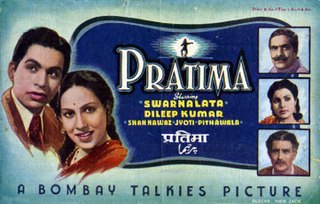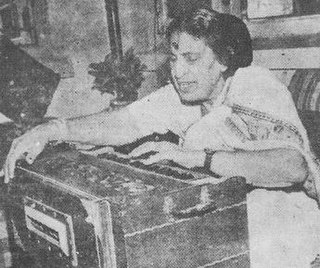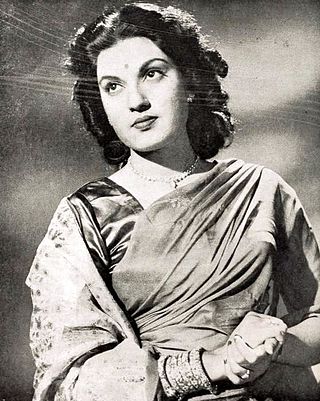
Devika Rani Choudhuri, usually known as Devika Rani, was an Indian actress who was active in Hindi films during the 1930s and 1940s. She was the first recipient of the Dadasaheb Phalke Award. Widely acknowledged as the first lady of Indian cinema, Devika Rani had a successful film career that spanned 10 years.

Ashok Kumar, was an Indian actor who attained iconic status in Indian cinema. He was a pioneering actor who introduced natural acting to Hindi cinema. He is considered the first superstar of Hindi cinema in the black-and-white era of the 40s and 50s as well as the first lead actor to play an anti-hero. He also became the first star to reinvent himself, enjoying a long and hugely successful career as a character actor. He was a member of the cinematic Ganguly family. He was honoured in 1988 with the Dadasaheb Phalke Award, the highest national award for cinema artists, by the Government of India. He also received the Padma Bhushan in 1999 for his contributions to Indian cinema.

Himanshu Rai was an Indian actor and film director. Regarded as one of the pioneers of Indian cinema, he is best known as the founder of the studio in 1934, along with Devika Rani. He was associated with a number of movies, including Goddess (1922), The Light of Asia (1925), Shiraz (1928), A Throw of Dice (1929) and Karma (1933). He was married to actress Devika Rani Chaudhuri (1929–1940).

Sashadhar Mukherjee was an Indian filmmaker in Hindi cinema. He started his career with Bombay Talkies in the 1930s, and later established Filmistan Studio with Rai Bahadur Chunilal, Ashok Kumar and Gyan Mukherjee in 1943. In the 1950s, he went on to start his independent studio, Filmalaya. He is noted for films like Dil Deke Dekho (1959), Love in Simla (1960), Ek Musafir Ek Hasina (1962) and Leader (1964). He is part of the distinguished Mukherjee clan of Bollywood.

Kismet (transl. Fate) is a 1943 Indian drama film, directed by Gyan Mukherjee, written by Mukherjee with Aghajani Kashmeri, and produced by Bombay Talkies, during the Second World War, while it was in a succession battle between Devika Rani and Sashadhar Mukherjee after owner Himanshu Rai's death. The film was the first big hit in the history of Bombay cinema, and the first blockbuster in Indian cinema.
Niranjan Pal was an Indian playwright, screenwriter, and director in the Indian film industry in the silent and early talkie days. He was a close associate of Himanshu Rai and Franz Osten, with whom he was a founding member of Bombay Talkies.

Achhut Kannya is a 1936 Indian Hindi film. Among the early super-hits in the Bombay film industry, the film deals with the social position of Dalit girls and is considered a reformist period-piece.

Jeevan Naiya is a 1936 Hindi film directed by Franz Osten, and produced by Himanshu Rai for his studio Bombay Talkies. It is famous for being the screen debut early superstar Ashok Kumar. The film is about the ostracism of dancing girls. The film was one of several successful Bombay Talkies collaborations between Franz Osten, Himashu Rai, screenwriters J. S. Kashyap and Niranjan Pal, and their leading lady of the time, Devika Rani.

Pratima is a 1945 Indian Hindustani-language movie directed by Paidi Jairaj. The film was produced by Bombay Talkies and was the directorial debut of P. Jairaj. The film stars Dilip Kumar, Swaran Lata, Mumtaz Ali, Shah Nawaz and Mukri. Swarn Lata was cast following her big success the preceding year, Rattan (1944). Mukri was cast in his debut role by Devika Rani, who is stated to have "liked his smile and off-screen enthusiasm". The music direction was by Arun Kumar Mukherjee and the lyricist was Narendra Sharma.
Filmistan is an Indian film studio based in Goregaon, Mumbai. Spread over five acres, near Patkar College on S.V. Road, the studio has seven shooting floors, and a temple and garden for outdoor locations. Patkar College's reputation has increased due to this studio. It previously operated as a film production company as well.

Basant (transl. Spring) is a 1942 pre-partition Indian romantic musical film directed by Amiya Chakrabarty, produced by Bombay Talkies and starring Mumtaz Shanti and Madhubala along with Ulhas. It revolves around Uma (Shanti), who is left to dance on stage for money when her husband (Ulhas) abandons her.

Syed Wajid Hussain Rizvi, better known by his film screen name, Agha Jani Kashmiri, was an Indian screenwriter, former actor and Urdu poet.

Saraswati Devi, born Khorshed Minocher-Homji, was an Indian director of music and score composer who worked in Hindi cinema in the 1930s and 1940s. She is most noted for her score, Mein Ban ki Chiriyra Banke Bun Bun Bolun Re in Bombay Talkies's Achut Kanya (1936). She along with Nargis' mother & Sanjay Dutt's grandmother Jaddanbai is considered to be one of the first female music composers in Indian cinema.

Anjaan is a 1941 Indian Hindi-language film directed by Amiya Chakrabarty and produced by Bombay Talkies. It was Chakrabarty's first film direction. The film's story and screenplay were by Amiya Chakrabarty, with dialogues by J. S. Casshyap. The cinematography was by the debutant R. D. Mathur. Its music direction was by Pannalal Ghosh, with lyrics by Kavi Pradeep and P. L. Santoshi. The film starred Devika Rani, who had recently returned to films after a two-year absence, following the death of her husband Himanshu Rai in 1940. The cast included Ashok Kumar, David, V. H. Desai, Gulab, Suresh and Om Prakash.

Mumtaz Ali was an Indian dancer and character actor in Hindi cinema from the 1940s to 1970s. He was the father of Indian actor Mehmood. He also had his own dance troupe "Mumtaz Ali Nites" which performed all over India. His career slumped due to his excessive drinking and his family fell into hard times, leading to his son Mehmood to work as a child artist and daughter Minoo Mumtaz to work as dancer in his stage shows and later in movies.

Gyan Mukherjee was an Indian film director and screenwriter, who worked in Hindi cinema, best known for the hits Jhoola (1941) and Kismet (1943).

Izzat (transl. Honour) is a 1937 Hindi film social drama, directed by Franz Osten. The film was produced by Himanshu Rai for Bombay Talkies. The credit roll of Izzat attributes the story to Dr. G. Nundy, adapted for screen by J. Nundy. The screenplay was by Niranjan Pal, who handled the story section of Bombay Talkies. J. S. Casshyap wrote the songs and dialogues and was assisted in dialogue direction by S. I. Hassan. The music was composed by Saraswati Devi, with actor Mumtaz Ali doubling as the choreographer. The film starred Ashok Kumar with Devika Rani in the lead, while the rest of the cast included Mumtaz Ali, Madhurika, Kamtaprasad, Chandraprabha, and P. F. Pithawala.

Savitri is a 1937 mythology legend Hindi film directed by Franz Osten. Adapted from a story in the Mahabharata the writers were Niranjan Pal with dialogues by J. S. Casshyap. The cinematographer was Joseph Wirsching. Saraswati Devi composed the music. According to Garga, Savitri was the "only mythological" produced by Himanshu Rai for Bombay Talkies, who were known for making "rurlist reform dramas". Ashok Kumar and Devika Rani played the lead roles supported by Maya Devi, Saroj Borkar, Mumtaz Ali, and Sunita Devi.

Vachan is a 1938 costume drama Hindi film directed by Franz Osten. The regular Bombay Talkies writer, Niranjan Pal, walked out of the Bombay Talkies production team after an altercation with Himanshu Rai in 1936. Saradindu Bandyopadhyay, a famous writer known also for creating Byomkesh Bakshi, replaced Pal in the story department, writing for films like Nirmala and Vachan in 1938 and Durga in 1939. The screenplay was by Agha Jani Kashmiri, with dialogues and lyrics by J. S. Kashyap. The music was composed by Saraswati Devi aided by J. S. Kashyap. The film starred Devika Rani and Ashok Kumar, a popular pair from Bombay Talkies who worked in seven films together. Devika Rani remained the bigger star with Kumar's name being "over-shadowed" in the credit rolls, as well as the publicity of the film.

Munawar Sultana was an Indian cinema actress, who acted in Hindi films. She is cited as one of the "popular" actresses of the late 1940s to early 1950s period, along with Noor Jehan, Swarnalata and Ragini. Her specialty was playing a selfless woman, enduring the rough treatment meted by her husband and family, but who eventually "brought her erring husband back home".


















